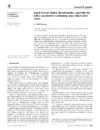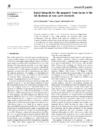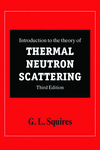issue contents
September 2012 issue

Cover illustration: The sequence of constructing the cartwheel pattern of the first-level hierarchy of the quasi-periodic pattern on the interior walls of the courtyard of the Madrasa of al-'Attarin (1323), Fez, Morocco [Al Ajlouni (2012). Acta Cryst. A68, 235-243].
research papers
A new error-stable Bravais-lattice determination algorithm is proposed and compared with the method of Andrews & Bernstein.
This article describes and demonstrates the use of clustering methods to determine the unit-cell parameters for three-dimensional single-crystal electron-diffraction data which are noisy and often limited. The approach is general and can also be applied to single-crystal X-ray data.
The generalized multicomponent short-range order parameter was adapted for atom-probe tomography (APT), to model, measure and simulate the short-range order in multicomponent material systems. The results were utilized in Monte Carlo simulations to replicate the corresponding complete and lattice-based data sets, free of the experimental limitations of APT data.
An algorithm is presented for calculating the fast fluctuation scattering parameter via the three-dimensional Zernike polynomial expansion method.
Download citation


Download citation


The dynamic electron densities of multipole models and independent atom models are computed by inverse Fourier transform of accurately computed structure factors of α-glycine and D,L-serine at different temperatures. A topological analysis of the dynamic electron densities provides a quantitative measure for the effects of zero-point vibrations and temperature on electron densities.
The explicit correspondence between rod groups and relevant geometric realisations of the corresponding line groups is established to lay a bridge between crystallography and the theory of stereoregular polymers.
The radial integrals 〈jL〉, where L = 0, 2, 4, for several electronic configurations of the 5d electrons of rare earth elements are calculated. Gaussian analytical expressions with four exponential terms are fitted to the resultant values and the coefficients of the expressions are tabulated.
The possible distortions in the spinel structure resulting from rotation of the tetrahedra and octahedra are investigated by a group-theoretical method. The possibility of the existence of 28 phases of rotation of the tetrahedra and five phases of rotation of the octahedra is shown.
international union of crystallography
Free 

book reviews
Free 



 journal menu
journal menu





























